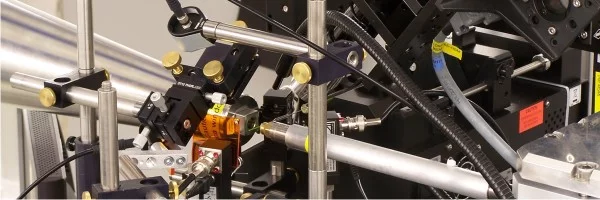
cSAXS is a beamline dedicated to small-angle X-ray scattering (SAXS) and coherent diffractive imaging, particularly ptychography, located at the Swiss Light Source at the Paul Scherrer Institut in Villigen, Switzerland. See the beamline's endstations website for information on experimental setups, geometries, and sample preparation details. We strongly encourage all prospective users to discuss their experimental plans with the beamline staff before submitting proposals.
Access to cSAXS is granted through the biannual SLS call for proposals. Access to PSI data analysis center is described in Photon Science Data Analysis.
Experiment types
Experiments performed at cSAXS include, inter alia,
- Ptychographic nanotomography, see for example Dierolf et al., Nature 467, 436 (2010) or Holler et al., Nature Electronics 2, 464 (2019). Dedicated instrumentation, available to users, is described in Holler et al., Sci. Rep. 4, 3857 (2014), Holler et al., Rev. Sci. Instrum. 88, 113701 (2017), Holler et al., Rev. Sci. Instrum. 89, 043706 (2018), and Holler et al., J. Synchrotron Rad. 27, 730 (2020).
- Optics characterization, see for example: Vila-Comamala et al. Opt Express 19, 21333 (2011)
- Small-angle X-ray scattering (SAXS), e.g., Smeulders et al., Nature 478, 412 (2011), can be performed with spatial resolution as microscopy technique in 2D (Bunk et al. New J. Phys. 11, 123016 (2009)) and 3D (Liebi et al. Nature 527, 349 (2015)). SAXS is also available with time resolution in the millisecond range (Westenhoff et al., Nature Methods 7, 775 (2010)).
Setup Images
Images of some typical setups can be found under Endstations.
Technical Data
| Energy range | 4.4 – 17.9 keV |
|---|---|
| Energy resolution | ΔE/E < 0.02% |
| Spot size on sample (horizontal × vertical) | variable from 1.5 × 0.8mm2 to 25 × 10µm2. Smaller beam sizes are possible using Fresnel zoneplate lenses, for more details contact the beamline staff |
| total flux (at sample position)* | ~2x1012photons/sec (at E = 6.2keV, 400mA ring current) ~1x1012photons/sec (at E = 11.2keV, 400mA ring current) ~5x1011photons/sec (at E = 13.6keV, 400mA ring current) |
| Coherent flux** | ~7×108photons/sec (at E = 6.2keV, 400mA ring current) |
| q-range (@11.2 keV)† | SAXS detector at 7.2 m, q = [0.0012, 0.1]Å-1, d-spacing = [524, 6.28] nm. SAXS detector at 2.1 m, q = [0.004, 0.34]Å-1, d-spacing = [157, 1.85] nm. WAXS detector [0.64, 2.8]Å-1, d-spacing = [1, 0.22] nm (vertically oriented strip detector, no orientation information from anisotropic scattering is available for the WAXS detector). |
*measured with scattering from calibrated glassy carbon (Fan Zhang et. al., Metallurgical and Materials Transactions A, DOI: 10.1007/s11661-009-9950-x) for 11.2 keV and 13.6 keV and crossed checked with a transmission diode, for 6.2 keV only the diode measurement is given. All measurements were carried with an entrance slit aperture of 0.5 mm x 0.5 mm and scaled up to the whole beam size of 1 mm x 0.7 mm. Note that the flux at the sample position depends on specific experimental settings and optics used. Please contact the beamline staff to get more information.
**at the sample position in a beam focused by a Fresnel zoneplate with 60 nm outermost zonewidth and approximate beam waist diameter of 100 nm.
† the lower ends of the q-range for the SAXS detector require a special beamstop arrangement and are significantly more affected by parasitic scattering. If you need very low q-range information, below e.g. 0.002 Å-1, please discuss your experiment ahead of time with the beamline staff.

